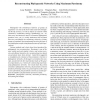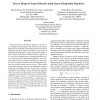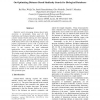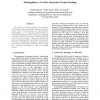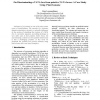CSB
2005
IEEE
14 years 5 months ago
2005
IEEE
Phylogenies—the evolutionary histories of groups of organisms—are one of the most widely used tools throughout the life sciences, as well as objects of research within systema...
CSB
2005
IEEE
14 years 5 months ago
2005
IEEE
Metals bound to the protein are important for functional or structural roles. Despite their importance there is a distinct lack of research for identification of metalloproteins f...
CSB
2005
IEEE
14 years 5 months ago
2005
IEEE
Recently Bowers et al. [1] analyzed triplet logic relationships among 4873 Clusters of Orthologous Groups (COGS) from 67 fully sequenced organisms by calculating how well logic re...
CSB
2005
IEEE
14 years 5 months ago
2005
IEEE
We have previously developed a method [1] for the inverse design of small ligands. This method can be used to design novel compounds with optimized properties (such as drugs) and ...
CSB
2005
IEEE
14 years 5 months ago
2005
IEEE
This work presents the development of algorithms for approximate string matching using parallel methods. It intends to do the maximum of molecular sequences comparisons per unity ...
CSB
2005
IEEE
14 years 5 months ago
2005
IEEE
Similarity search leveraging distance-based index structures is increasingly being used for both multimedia and biological database applications. We consider distance-based indexi...
CSB
2005
IEEE
14 years 5 months ago
2005
IEEE
We present TreeRefiner, a tool for refining multiple alignments of biological sequences. Given a multiple alignment, a phylogenetic tree, and scoring parameters as input, TreeRefi...
CSB
2005
IEEE
14 years 5 months ago
2005
IEEE
PCR, the polymerase chain reaction, is a fundamental tool of molecular biology. Quantitative PCR is the goldstandard methodology for determination of DNA copy numbers, quantitatin...
CSB
2005
IEEE
14 years 5 months ago
2005
IEEE
The molecular docking problem is to determine how molecules interact with other molecules and plays a key role in understanding how cells function. DockingShop is an integrated en...
CSB
2005
IEEE
14 years 5 months ago
2005
IEEE
